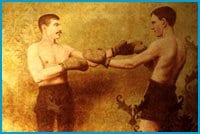Sometimes there is comfort in the familiar, while other times it just feels… familiar. Patrick DeCoste’s new body of work, Below The Belt, is filled with gay tropes: wrestling, dandies, patterning and shiny male torsos in some combination or other. Most people understand wrestling is erotic and that gay art and male nudity were meant for each other, but that doesn’t make these ideas challenging. If you like your art to be fierce you might want to sit this one out. But if you like shiny, luscious man art this is definitely your deal. Below The Belt is a collection of richly textured and heavily varnished acrylic paintings on upholstery fabric.
Below The Belt is inspired by Montreal-based poet Ann Carson’s Men In The Off Hours. Carson’s book is described by Salon.com as a “picnic of sex and love and death,” which pretty much sums up Below The Belt, too. Though the work is definitely on the male side of things, it is not necessarily an exploration of masculinity, but rather a running commentary on the idea or perception of masculinity. In “Boxers,” for example, two handsome men in boxing attire face one another, but that’s as far as their competition and aggression go. Their faces are relaxed, and their distance from one another makes them seem posed rather than punchy. Reminiscent of Physique Pictorial photos, everyone knows they aren’t really boxers, but it’s a good excuse to look at shirtless guys.
As a way of emphasizing the “Boxers” aesthetic value, DeCoste has painted them on upholstery fabric. The men alternate between standing in front of what appears to be wallpaper, to having their nether regions highlighted by the patterning. The wallpaper effect also places the men in a domestic setting rather than a boxing ring. The intimacy of the private space the men occupy is contrasted by their stilted pose.
This selection of paintings alternates between more polished, refined works such as “Boxers” and works such as “Soccer Players” which have been left as underpaintings. While both styles of work have their own merits, the underpainted pieces seem to be a departure from DeCoste’s previous, more painstakingly crafted work. During my visit to the gallery someone wondered aloud whether or not the works have actually been finished or if the exhibition crept up a little too quickly for the artist. The walls will never tell.
One of the less explicit themes in Below The Belt is the idea of space. Its exploration, both physically and ideologically, runs throughout the exhibit. At close range some of the underpainted works don’t look like much of anything, but as the viewer backs up, an image becomes more recognizable. Within the paintings themselves, there is another exploration of space, of the intimacy and distance between men and how that plays out in relationships.
This exhibition also contains a few older pieces from previous series: Portrait Of The Artist As A Dead Man and Silenus In Furs. The works are beautifully done, but seem a bit incongruous when compared directly against the newer work.
With the onset of fall DeCoste’s colour palette seems particularly timely. He paints in all the shades of brown with some green here and there for good measure. As the weather changes, and shirtless men become more and more rare on the street, we can be thankful that at least one gallery will give us a bit of a tease.

 Why you can trust Xtra
Why you can trust Xtra


